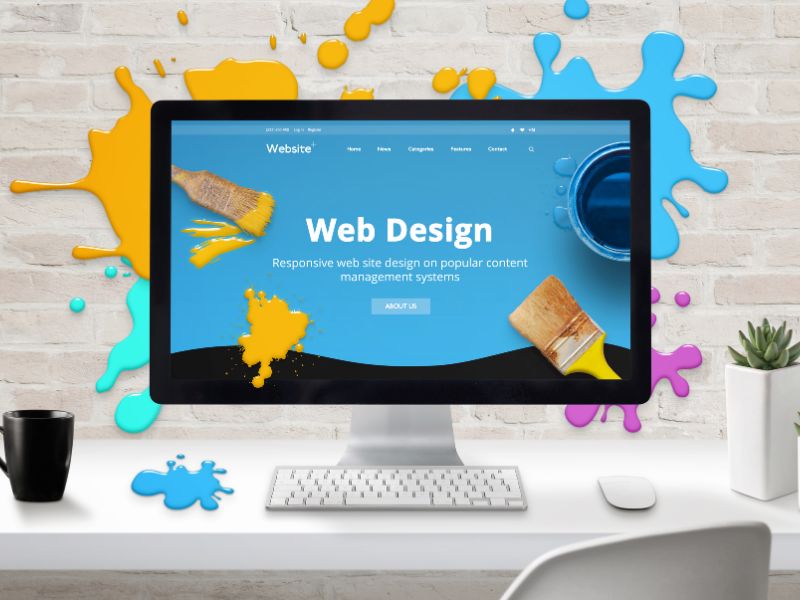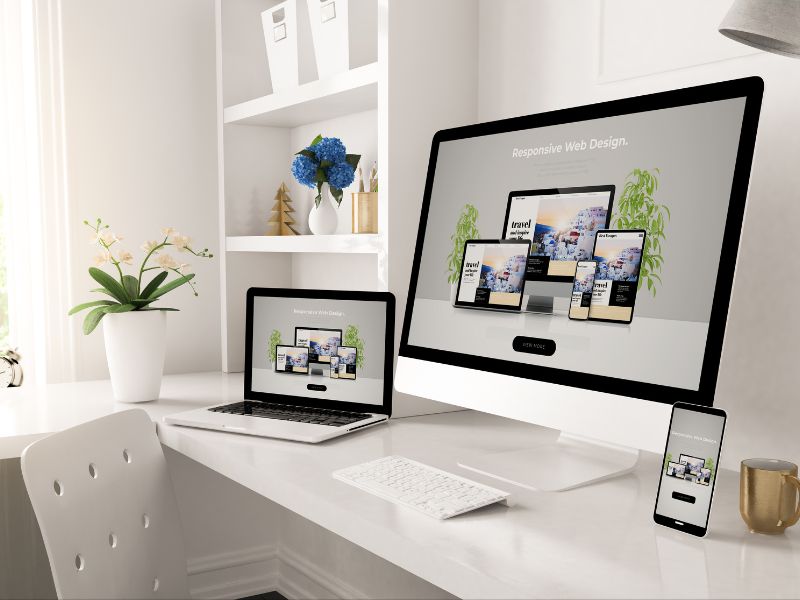Imagine a canvas that stretches beyond the horizon, one where the brushstrokes of creativity meld with the precision of technical skill to craft experiences that resonate with the soul. Web design, an art form that dances on the digital stage, invites one to wield the power of color, layout, and typography to invoke emotions and convey messages as diverse as the human experience itself. Each website, a unique masterpiece, reflects an individual story, vibrant and alive, beckoning visitors to step into a world meticulously woven from imagination and purpose.
There’s a certain magic in the way web design marries functionality with beauty, creating a symphony of user interaction that delights the senses and simplifies the complex. The harmonious blend of images that whisper tales of adventure, icons that guide like stars in the night, and navigation that flows like a river through the valley of content, all work in concert to offer an oasis of order amidst the chaos of the infinite internet. It’s in these details that the heart finds joy, and the mind acknowledges the undeniable reasons to love the craft of web design.
The Power of JS in Web Design
Venture into the landscape where JS examples blossom like spring flowers, showcasing the versatility of JavaScript in web design. Each petal represents an array of JS applications, a testament to the language’s ability to breathe life into dynamic pages. Imagine JS apps as intricate puzzles, where each piece, a JS component, fits seamlessly to create a cohesive picture. The JS cod swims through the digital sea, weaving together application components with the elegance of a maestro.
Witness the canvas of the web painted with innovative designs, as the JS framework becomes the brush and palette for creators. JS handles the intricacies of interactivity with ease, setting a JS default for user engagement.
Exploring JS Examples and Applications
As the curtain rises on the landscape of web development, the power of JavaScript (JS) emerges like a beacon of inventive potential. Exploring JS examples unveils a realm where dynamic user interfaces greet visitors with seamless interactivity. Through the looking glass of webtestit JS charts, data comes alive, transforming numbers into captivating visual stories that engage and enlighten.
Venturing further into the diverse ecosystem of JS applications, one discovers the versatility of JS apps, where each serves a unique purpose. A JS framework can metamorphose a static webpage into a bustling marketplace, pulsating with live updates and user engagement. The fusioncharts JS editor stands as a testament to the beauty of data visualization, where complex datasets are elegantly simplified into stunning, interactive graphs and charts.
With different applications of JS components, developers are equipped to construct a landscape that resonates with the vivacity of JS cod.
Building with JS Components
As the conversation evolves, the focus now shifts towards the intricate craftsmanship possible with JavaScript building blocks. Immersing oneself in the realm of JavaScript instills a sense of boundless possibility, where the canvas of a web page is transformed with interactive and dynamic features. Through the thoughtful assembly of these building blocks, vibrant and responsive user interfaces spring to life.
Imagine a digital mosaic, each tile a snippet of code that, when combined, culminates in a seamless user experience. Menus slide into view with a fluid grace, tabs toggle with a satisfying click, and modal windows fade into existence as if conjured by digital sorcery. Each element, meticulously engineered, contributes to the symphony of the webpage’s operation.
By delving into JS examples, one discovers galleries of images that respond to the slightest touch, accordion lists that disclose content with an elegant ease, and forms that validate input in real-time, guiding users with gentle prompts and suggestions.
Unleashing Creativity with Innovative Designs
As we meander through the enchanting world of JavaScript, let’s delve into how it acts as a catalyst for creativity in web design. Imagine a canvas where the only limit is the horizon of one’s imagination. JavaScript provides that very canvas, enabling designers to paint digital experiences with strokes of code that come alive on the screen.
With every line of JavaScript, a static webpage transforms into a dynamic masterpiece. Envision animations that dance across the screen in response to user interactions, or layouts that shift elegantly to present content in the most engaging way possible. These are not mere js examples; they are the embodiment of creativity unleashed.
The mastery of JavaScript invites a symphony of visual effects, from parallax scrolling that adds depth and dimension to a site to interactive storytelling that captivates audiences. Each website becomes a unique story, a bespoke experience tailored to invoke emotion and action. Through JavaScript, the once mundane task of navigating a website becomes an adventure, a journey of discovery where each click unveils something new and wonderful.

Coding Bootcamps: Your Gateway to Web Design
Dive into the transformative world of coding bootcamps, where novices emerge as skilled web designers, weaving success stories bootcamps are known for. Each tale is a tapestry of relentless effort and mentor support, guiding learners as they decode the mysteries of coding. Imagine the satisfaction as one’s skills ascend to the next level, unlocking new job choices and a salary boost – a testament to the potency of coding bootcamps.
As the digital landscape evolves, coding bootcamps also embrace remote work, a trend sweeping across industries. They prepare graduates not just for today’s market but for a future where web design can be done from anywhere.
Unraveling Success Stories from Bootcamps
Harnessing the transformative energy of JavaScript in web design is akin to finding a hidden treasure map; it reveals pathways to uncharted territories of creativity and efficiency. Yet, the journey to mastery can be arduous and solitary. In this landscape, coding bootcamps emerge as bustling oases, teeming with tales of transformation and triumph.
Within these intensive training grounds, aspirants from diverse backgrounds converge, fueled by a common goal: to elevate their craft to the next level. They immerse themselves in rigorous curricula, their fingers dancing across keyboards, breathing life into lines of code that blossom into elegant, responsive designs. As days melt into nights, a camaraderie forms—a network of budding web designers, each a beacon of potential.
The chronicles of those who have navigated the coding bootcamps’ challenging terrain are nothing short of remarkable. One hears of a barista who, with each clack of the keyboard, poured her determination into learning, eventually emerging as a sought-after designer in the realm of remote work.
Taking Your Skills to the Next Level
As you harness the exuberant power of JavaScript in sprucing up digital canvases, the journey to mastery beckons—a path often paved through the rigorous yet rewarding experiences of coding bootcamps. These intensive training grounds offer a veritable treasure map for those seeking to elevate their web design prowess. Imagine entering a world where, within weeks, the once-daunting code becomes a familiar friend, guiding you through the nuances of sophisticated web aesthetics and interactive features.
Coding bootcamps, with their dynamic curriculum, are akin to digital dojos where every keystroke sharpens your skills, and every project is a step closer to proficiency. The accelerated learning environment is meticulously crafted to simulate real-world challenges, pushing you to adapt, innovate, and overcome. As you dive deeper, the intricacies of responsive design, user experience, and performance optimization unfold like a blossoming digital flower.
Embracing the Remote Work Trend in Web Design
As the digital tapestry of web design continually evolves, coding bootcamps offer a bridge to the latest trend sweeping the industry: the embrace of telecommuting. Picture a world where the commute is merely the distance from the bedroom to the home office, where global collaboration is not just possible but the norm. Coding bootcamps are at the forefront, equipping aspiring designers with the know-how to thrive in this virtual environment.
The curriculum of these bootcamps often includes modules on how to effectively collaborate and manage projects across digital platforms, mimicking the distributed teams found in modern tech companies. They dissect the nuances of asynchronous communication and the use of project management tools that keep teams in sync, despite physical distances. With an emphasis on real-world scenarios, graduates emerge not just as skilled designers, but as maestros of the art of digital collaboration, ready to design stunning websites from any corner of the globe.
Building Responsive Applications: The New Norm in Web Design
Embarking on the journey of web application development, one sails through an ocean of responsive applications, where seamless functionality across various devices is not a luxury but the new norm. As artisans of the digital canvas, mastering the product development process becomes paramount, ensuring that every stroke contributes to a masterpiece of user engagement and interaction. Imagine crafting a mail client app – this case study epitomizes the intricate tapestry of product development, woven with threads of learning focus and learning flexibility. Each feature, a testament to meticulous portfolio development, while the underlying payment policy assures value for both creator and user.
Understanding Web Application Development
Stepping beyond the fundamentals of web design, one enters the intricate realm of crafting comprehensive online experiences. Understanding Web Application Development is akin to unraveling a digital tapestry, where each thread represents a crucial aspect of creating dynamic, interactive platforms. At the heart of this process lies product development, a meticulously orchestrated sequence of steps from ideation to launch.
Imagine a canvas where vibrant functionalities and user-centric designs converge, and the artist—armed with a palette of programming languages, frameworks, and tools—brings forth a seamless online application. This canvas is not static; rather, it is fluid, adapting elegantly to the myriad devices that access it. Product development demands an intimate understanding of both back-end operations, which ensure the application’s engine runs smoothly, and front-end aesthetics that captivate and engage users.
In this arena, every line of code is purposeful, every interface element is intentional, and the user’s journey is paramount.
Mastering the Product Development Process
As the conversation gracefully transitions from the immersive world of educational programs, another crucial facet of web design beckons—a deep dive into the heart of crafting digital solutions. Mastering the art of product creation is akin to conducting an orchestra; each phase must harmonize with precision to manifest a symphony of user-centric functionality.
This process begins with the meticulous crafting of a product roadmap, a strategic blueprint that guides the journey from conception to launch. Here, each feature is carefully weighed for its impact and sequenced for development, ensuring that the final product resonates with its intended audience. The design phase weaves aesthetics with usability, creating an interface that delights and engages.
Next, the development stage transforms static designs into dynamic experiences, breathing life into the product through elegant lines of code and robust architecture. Quality assurance then takes center stage, rigorously testing each aspect to ensure seamless performance. Finally, the launch is not the end but the commencement of continuous refinement, as feedback becomes the nourishment for future innovation and growth.
Creating a Mail Client App: A Case Study
Bridging the gap between theory and practice, constructing a functional mail client serves as an illustrative beacon for aspiring web designers. Envision a digital workshop where creativity marries technical prowess, culminating in the creation of a mail client that not only sends and receives emails but does so with an intuitive flair. Through this case study, the intricacies of user interface design are unwrapped, revealing a tapestry of interactive elements that invite engagement.
Imagine the crafting of an inbox that automatically categorizes messages, a task that demands an intricate understanding of user behavior. Visualize a compose window where attachments are not merely added but presented with thumbnail previews, adding a layer of convenience and sophistication. The search functionality is no longer a bland box but a dynamic tool that predicts queries and showcases results in real-time, a testament to the meticulous attention to detail.
In this journey, the mail client transforms from a mere concept to a tangible asset, demonstrating the harmonious blend of aesthetics and functionality that stands at the heart of web design.
The Undeniable Reasons Series: A Closer Look
Immerse in a digital tapestry where DSD clinics bloom into web design marvels, a narrative of transformation unfurls. The DSD Clinic landscape, once a canvas of traditional aesthetics, now thrives with vibrant online presences, each site a testament to tailored user experiences. Through the prism of social media, DSD social media channels gleam, reflecting the meticulous craft—a fusion of visual storytelling and interactive engagement.
Behold the tale of Christian Coachman social media prowess, where strategic web design converges with social platforms, casting a wider net of influence and connectivity.
DSD Clinics: A Web Design Success Story
From the fluidity of responsive web design, let’s pivot to a tale of transformation where aesthetics meet functionality in the digital world. Enter the realm of DSD Clinics, a narrative that exemplifies the harmonious blend of visual appeal and user experience in web design.
DSD Clinics, illustrious for revolutionizing smiles, now wear a crown for their online presence as well. The journey of these clinics’ digital makeover is nothing short of inspiring. With a website as sleek as the smiles they craft, DSD Clinics have set a benchmark for dental and medical professionals aspiring for a career change in their online imagery.
The meticulously curated web design of DSD Clinics leads you through a virtual tour of their serene interiors, displaying clinic status with real-time updates, thus keeping patients informed and engaged. The use of calming colors, intuitive navigation, and interactive elements in DSD Clinic’s website mirrors the attention to detail and care they pour into every patient encounter.
Social Media and Web Design: A Christian Coachman Case Study
As the digital tapestry of our world continues to evolve, so does the symbiotic relationship between social media and web design. Through the lens of the Christian Coachman case study, one witnesses an artful weaving of strategy and aesthetics that has revolutionized the way DSD clinics engage with their audience. On platforms where a single scroll dictates the fate of content, DSD clinics have mastered the craft of capturing attention with a harmonious blend of visual storytelling and interactive elements.
From the crisp, inviting images that showcase the transformative smiles designed by DSD clinics, to the informative posts that update followers on clinic status, the social media presence of these clinics is a testament to the power of web design in creating cohesive online personalities. As Coachman’s case study reveals, each post serves as a digital handshake, welcoming potential patients into a world where attention to detail and patient satisfaction are paramount.
Regular updates on DSD clinic status seamlessly merge with the aesthetic, ensuring that while beauty draws the eye, functionality and up-to-date information secure user engagement.
Keeping Up with the Latest DSD Clinic Status
As the digital landscape unfurls like a map to new territories, DSD Clinics represent oases of innovation in the sprawling web design desert. To keep abreast of the latest updates from these centers of digital smile design, one must become a sleuth in the ever-evolving online world.
Imagine a virtual bulletin board, a hive of activity with fresh updates on DSD Clinic offerings, patient testimonials, and technological advancements. This board pulsates with life, continuously fed by the stream of new information. It’s a place where the vibrancy of the DSD Clinics’ services is as apparent as the bright smiles they craft.
Navigating through this digital mosaic, enthusiasts and prospective patients alike can witness the evolution of DSD Clinics. The calendar of events blossoms with upcoming workshops, while the gallery of before-and-after photos showcases transformative dental artistry. Each byte of data adds a new stroke to the ever-expanding portrait of DSD Clinics’ commitment to excellence in the realm of aesthetic dentistry.

Blogging and Web Design: A Powerful Duo
Crafting the latest blog post becomes an art form when web design weaves its magic, creating a tapestry that captures and holds the eye. This synergy blossoms at the crossroads where business & marketing blogs intersect with aesthetic innovation, each post a digital handshake greeting every visitor with a warm embrace. As blog notifications chime like a well-tuned orchestra, inviting readers back, the topic of money matters takes center stage on finance blogs. Here, the marriage of fiscal wisdom with sleek design translates complex concepts into engaging stories, turning browsers into believers in the power of well-crafted content.
Crafting Your Latest Blog Post with Web Design
As the kaleidoscope of the digital world continues to turn, the artistry of web design becomes increasingly pivotal in the tapestry of online communication. Imagine stepping into a realm where every pixel, every hue, and every font choice weaves together to tell a compelling story. Crafting your most recent narrative in the form of a blog post transcends mere words on a screen; it necessitates a harmonious fusion with web design.
Picture the layout of your blog as a canvas, where the alignment of text, the selection of images, and the interplay of colors breathe life into your message. The subtleties of typography set the mood, leading readers through a visual journey that complements the rhythm of your prose. Navigation is crafted not as a mere function but as an intuitive guide, ushering visitors through the revelations of your writing with effortless fluidity.
The Intersection of Business, Marketing, and Web Design Blogs
As we weave through the digital tapestry of content creation, the confluence of business, marketing, and web design in the blogging sphere emerges as a vibrant thread. Imagine a bustling digital marketplace, where every blog is a stall showcasing its unique wares, vying for the attention of passersby. In this realm, the fusion of business acumen with marketing savvy, all wrapped in the embrace of stunning web design, becomes not just an advantage, but a necessity.
Diving into this intersection, one discovers a world where strategic layouts serve as the framework for compelling content. Headers, footers, and sidebars don’t merely exist; they perform like seasoned market vendors, guiding visitors through the journey of knowledge and persuasion. The color palettes, typography, and imagery chosen aren’t just aesthetic choices—they’re silent salespeople, whispering the values and vision of the brand into the subconscious of each reader.
Money Matters: Web Design for Finance Blogs
As we navigate away from the broad horizons of the previous discussions, we find ourselves delving into the intricate world of finance blogs, where clarity and trust are the currencies of the realm. In the realm of finance blogs, web design takes on the role of a meticulous banker, ensuring every pixel is invested wisely to yield user trust and comprehension.
Imagine stepping into a virtual lobby, where the aesthetics are as secure and inviting as a vault in an esteemed bank. Here, the web design for finance blogs must resonate with the principles of the financial world – precision, efficiency, and reliability. Crisp lines and a palette of trust-inducing blues and greens craft a visual harmony that speaks of fiscal responsibility. Charts and graphs emerge not merely as visual aids, but as pillars of transparency, transforming complex data into digestible financial insights.
In this space, every design element acts as a guide, leading visitors through a labyrinth of market trends and economic advice with the ease of a seasoned financial adviser.
The Role of Living Hinges in Web Design
Embarking on the journey of web design, one encounters the meticulous craft of shaping living hinge prototypes. These flexible yet durable connectors, often sculpted from polypropylene, mirror the adaptability required in digital landscapes. Imagine living hinges as the unseen joints that bring fluidity to navigation; they embody the seamless transitions users expect. Comparing plastic living hinges with their metal counterparts offers insights into durability and user experience—qualities paramount in both physical and digital realms. Just as hinge types are pivotal in material design, in web design, the site map stands as the foundational blueprint, guiding visitors through a labyrinth of pages with the grace of well-oiled living hinges.
The Art of Creating Living Hinge Prototypes
As we weave through the tapestry of web design, let us pivot our attention towards an intriguing element of physical prototyping that has found its metaphorical counterpart in digital realms: the art of crafting living hinge prototypes. Envision the malleable yet resilient nature of living hinges, those thin strips allowing objects to bend without breaking. In the world of web design, creating living hinge prototypes parallels the process of building flexible yet robust user interfaces.
Imagine the designer as a skilled artisan, meticulously experimenting with materials to achieve the perfect degree of flexibility and durability. Just as polypropylene living hinge prototypes undergo numerous iterations to refine their function in the tangible world, web designers iterate lay-outs and features to ensure seamless user experiences. The dedication to crafting living hinge prototypes is an intricate dance of precision and creativity, as is the case with their digital counterparts.
In this realm, the choice between metal hinges and living hinges is significant. While metal hinges suggest rigidity and permanence, living hinges embody adaptability and endurance. The lesson here is clear:
Exploring Plastic vs Metal Hinges in Web Design
As we pivot from the harmonious interplay between blogging and web design, let’s delve deeper into a specific design element that often goes unnoticed yet is pivotal in seamless navigation: living hinges. Imagine a website as a bustling digital briefcase, with living hinges as the silent heroes ensuring a smooth and fluid experience as users explore the contents.
In the realm of web design, the choice between plastic and metal living hinges is akin to selecting the perfect accessory that complements an outfit. Plastic living hinges, akin to polypropylene living hinge prototypes, are celebrated for their flexibility and endurance. They bend without breaking, much like a website that adapts effortlessly to the ever-changing demands of its visitors.
On the flip side, metal living hinges exude a sense of robustness, their steely resolve reminiscent of websites built to withstand the test of time and heavy traffic. Yet, they lack the malleability of their plastic counterparts, sometimes resulting in a rigid user experience that can deter the fluidity of digital exploration.
The Site Map: A Vital Component of Web Design
As we weave through the intricacies of blogging and web design, the metaphorical ‘living hinges’ of a website beckon for exploration. These living hinges are not made of plastic or metal; rather, they are the pivotal elements that connect various parts of a website, ensuring fluid navigation. Enter the sitemap, the unsung hero of web architecture.
Imagine a tapestry of pathways, each thread representing a potential journey through the digital landscape. The sitemap is the master weaver of these threads, an essential blueprint that organizes content and directs visitors with seamless precision. It lays out the structure of a website, much like an architect’s plans, guiding the user through rooms of information with ease.
With living hinges, every transition is smooth, and similarly, a well-crafted sitemap enables a flow that feels natural, almost intuitive. It ensures that every nook and cranny of the website is discoverable, leaving no page unturned, no information hidden.
Conclusion
In the tapestry of the digital landscape, the artistry of web design beckons with its limitless creativity and problem-solving prowess. The JavaScript language dances across webpages, animating interfaces with both grace and purpose, offering a feast for the eyes and an intuitive path for navigation. The rush of bringing a static vision to an interactive reality is nothing short of magical, with the symphony of code and color crafting digital experiences that resonate deeply with users across the globe.
As the digital world evolves, so too does the fusion of blogging and design, each post elegantly wrapped in bespoke aesthetics to captivate and inform. Delicate, yet robust, living hinges in design demonstrate the harmonious blend of form and function, opening doors to seamless user experiences. One cannot help but marvel at the rich possibilities web design presents, an ever-expanding universe where the only limits are those of imagination.















